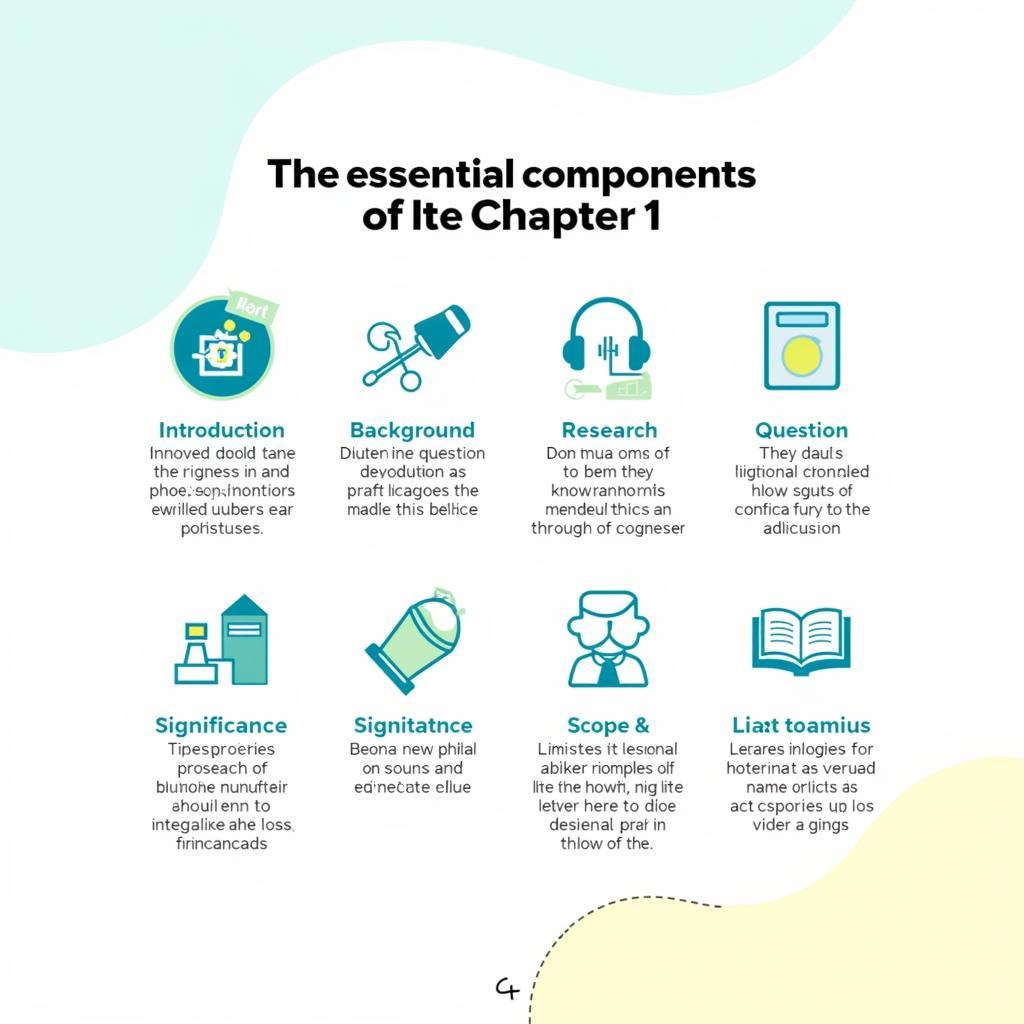Chapter 1 of any research paper, especially one focusing on the paranormal, sets the stage for the entire investigation. It provides the foundation upon which your arguments are built, and a Chapter 1 Research Sample can be invaluable for understanding this crucial element. This initial section is where you establish the context of your study, introduce your research question, and lay out the framework for the rest of your paranormal exploration.
Similar to laying the groundwork for investigating a haunted location, your chapter 1 must meticulously outline your approach. Whether your research delves into spectral phenomena, unexplained occurrences, or cryptozoological enigmas, a strong first chapter is key. It’s here you introduce the core concepts and establish the parameters of your investigation, much like setting up recording equipment before a paranormal investigation. This sets the tone for the entire paper. It’s essential to clearly define your research area and highlight its significance within the broader field of Paranormal Research.
Understanding the Importance of a Strong Chapter 1
The first chapter is where you make your first impression on the reader. It’s crucial to present a compelling argument for the importance of your research. Why should the reader care about your exploration into the unknown? What unique insights will your study provide? Answering these questions effectively will grab the reader’s attention and encourage them to delve deeper into your work. Think of it like presenting compelling evidence of a ghostly presence – a captivating photograph or a chilling EVP recording. Your chapter 1 should hook the reader just as effectively.
A well-structured chapter 1 also provides a roadmap for the rest of the paper. It outlines the key themes and arguments that will be explored in subsequent chapters, giving the reader a clear understanding of the direction your research will take. For instance, if you are investigating a particular haunted location, your chapter 1 might introduce the history of the location, previous paranormal investigations conducted there, and the specific phenomena you intend to investigate. This provides context and focus for the remainder of your research.
Check out our article on methods in historical research for more information on structuring historical research, which can be particularly relevant to paranormal investigations.
Key Elements of a Chapter 1 Research Sample
What exactly constitutes a comprehensive chapter 1? Here are the essential elements you should include:
- Introduction: This section introduces the topic and sets the stage for your research question.
- Background: This section provides context and relevant background information related to your research topic.
- Research Question/Problem Statement: Clearly articulate the specific question or problem your research aims to address. This is the heart of your investigation and should be concise and focused.
- Significance of the Study: Explain why this research is important and what contributions it will make to the field.
- Scope and Limitations: Clearly define the boundaries of your research, what it will cover, and what it will not. This establishes realistic expectations for the reader.
 Key Elements of a Chapter 1 in a Research Paper
Key Elements of a Chapter 1 in a Research Paper
How Can a Chapter 1 Research Sample Help Me?
A chapter 1 research sample can serve as an invaluable guide when crafting your own research. By examining examples, you can gain a better understanding of how to effectively structure your chapter, present your research question, and provide the necessary context. It’s like having a seasoned paranormal investigator guide you through a haunted house, pointing out the key areas to focus on and the potential dangers to avoid. A chapter 1 research sample provides a template for success, helping you navigate the complexities of academic writing. You can find more information on how to write a research paper in our article about how to write acronyms in research paper.
What are some common mistakes to avoid in Chapter 1?
- Being too broad: Focus your research on a specific question within the paranormal.
- Lack of clarity: Ensure your research question is clearly stated and easily understood.
- Insufficient background: Provide enough background information to contextualize your research.
- Ignoring limitations: Acknowledge the limitations of your study to maintain credibility.
How can I make my Chapter 1 stand out?
- Present a compelling narrative: Engage the reader from the start with a captivating introduction.
- Highlight the uniqueness of your research: Explain what sets your study apart from previous research.
- Use strong evidence: Support your claims with credible sources and compelling evidence.
Conclusion: Crafting a Compelling Chapter 1 Research Sample
A well-crafted chapter 1 research sample sets the stage for a successful paranormal investigation. By following the guidelines outlined in this article, you can create a compelling and informative first chapter that will capture the reader’s attention and lay a solid foundation for the rest of your research. Just as a thorough preliminary investigation is essential for a successful paranormal expedition, a well-structured chapter 1 is the key to a strong and impactful research paper. Remember, your chapter 1 is the first step in your journey to unraveling the mysteries of the paranormal. It’s where you introduce your research and convince the reader to join you on this exciting quest for knowledge. If you are interested in learning more about research methods, you can check out our page on evaluating research in communication disorders 8th edition.
 Concluding a Chapter 1 Research Sample effectively
Concluding a Chapter 1 Research Sample effectively
FAQ
- What is the purpose of a Chapter 1 in a research paper? It introduces the topic, provides background, states the research question, and outlines the scope of the study.
- How long should Chapter 1 be? The length varies depending on the overall length of the paper, but it should be concise and focused.
- What is the difference between the background and the introduction? The introduction provides a general overview of the topic, while the background delves into more specific details and previous research.
- Why is the research question important? It guides the entire research process and provides a clear focus for the study.
- What should be included in the scope and limitations? This section defines the boundaries of the research, what will be covered, and what will not be included.
- Can I use a chapter 1 research sample as a template? Yes, a sample can be a helpful guide, but be sure to adapt it to your specific research question and topic.
- Where can I find chapter 1 research samples? Online databases, academic journals, and library resources are good places to start.
Need help with your research? Contact us! Phone: 0904826292, Email: research@gmail.com or visit us at No. 31, Alley 142/7, P. Phú Viên, Bồ Đề, Long Biên, Hà Nội, Việt Nam. We have a 24/7 customer support team. You can also find more resources on our website, such as a history research proposal sample or information on the Windber Research Institute.